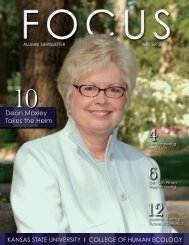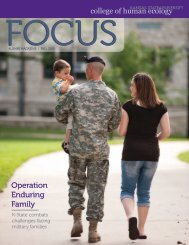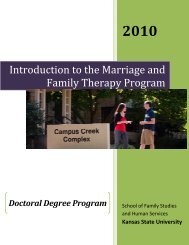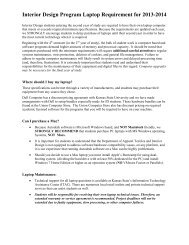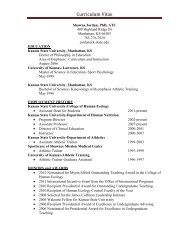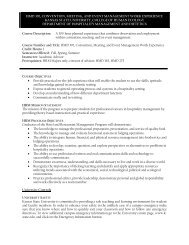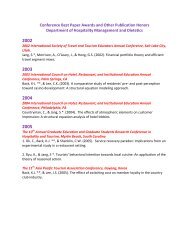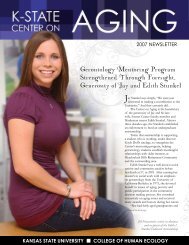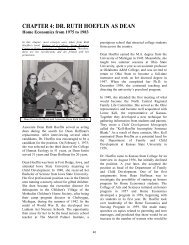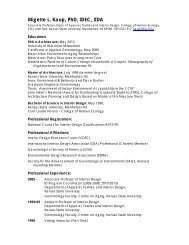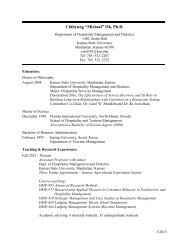Spring 2013 - College of Human Ecology - Kansas State University
Spring 2013 - College of Human Ecology - Kansas State University
Spring 2013 - College of Human Ecology - Kansas State University
You also want an ePaper? Increase the reach of your titles
YUMPU automatically turns print PDFs into web optimized ePapers that Google loves.
FOCUS<br />
“What is done for the boy in agriculture and engineering<br />
must be done for the girl in domestic science and art.”<br />
Past<br />
— Pr<strong>of</strong>essor Minnie A. Stoner at the dedication <strong>of</strong> Domestic Science Hall (later renamed for Nellie Kedzie) in 1898<br />
Kedzie, who personally lobbied the <strong>Kansas</strong> Legislature for the<br />
$16,000 needed for building and equipment. Kedzie headed home<br />
economics from 1882 to 1897 and was the first female pr<strong>of</strong>essor at<br />
K-<strong>State</strong>. The building was one <strong>of</strong> the first three named for campus<br />
leaders. They were Anderson Hall, Fairchild Hall and Kedzie Hall.<br />
Calvin Hall<br />
The next home, built<br />
in 1908, was the<br />
new $70,000 Calvin<br />
Hall, named after<br />
pr<strong>of</strong>essor Henrietta<br />
Willard Calvin. How<br />
modern we were<br />
— laboratories,<br />
lecture halls, sewing<br />
rooms, exhibit rooms, a large dining room with eight individual<br />
kitchens. We operated a cafeteria to feed students and to serve as a<br />
laboratory for institutional management students. Domestic Science<br />
now included home management, food instruction, home nursing,<br />
home sanitation, house building and furnishing. A nursery school<br />
opened in 1926 in Calvin Hall. Mary P. Van Zile, who was in charge<br />
<strong>of</strong> the curriculum, taught a class in table manners to senior men for<br />
25 cents, meal included. She discouraged them from drinking from<br />
saucers. That year football came to campus and a movie theater<br />
came to Manhattan. <strong>College</strong> President Ernest R. Nichols boasted <strong>of</strong><br />
an enrollment <strong>of</strong> 2,166 students at the university.<br />
Justin Hall<br />
$2,125,000. It was top <strong>of</strong> the line and included air conditioning, 28<br />
teaching labs, 23 research labs, eight classrooms and a lecture hall<br />
that seated 220. In 1985 the college became <strong>Human</strong> <strong>Ecology</strong>.<br />
Justin Hall expansion<br />
Justin Hall was built to accommodate a burgeoning student<br />
enrollment <strong>of</strong> 1,000. Student population had nudged the 2,000 mark<br />
and was still skyrocketing. The business <strong>of</strong> educating, researching<br />
and meeting the needs <strong>of</strong> students, staff and faculty changed.<br />
<strong>Human</strong> <strong>Ecology</strong> needed more space for students to work together,<br />
for seminars and large high-tech classrooms. In September 2012,<br />
Dean Virginia Moxley led dedication ceremonies for a 13,180-squarefoot<br />
expansion to 50-year-old Justin Hall. The $5-million addition was<br />
financed entirely by alumn and friends <strong>of</strong> the college.<br />
In 1959, the year the Carey brothers celebrated the first year <strong>of</strong><br />
the new business in Wichita called Pizza Hut, the <strong>College</strong> <strong>of</strong> Home<br />
Economics moved into Justin Hall. It was built under the judicious eye<br />
<strong>of</strong> Dean Doretta H<strong>of</strong>fman and named for Margaret Justin, who was<br />
dean for 31 years. The building boasted 102,004 square feet and cost<br />
1903<br />
5






